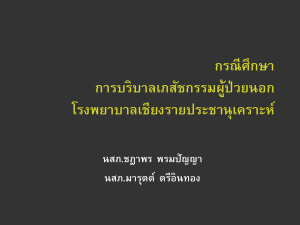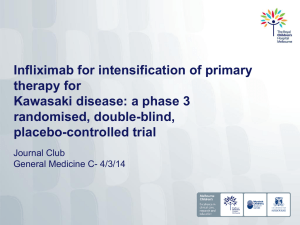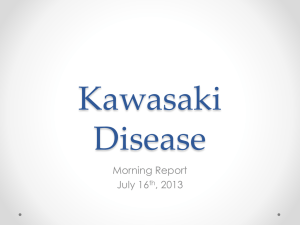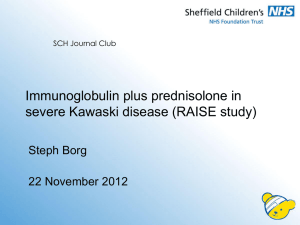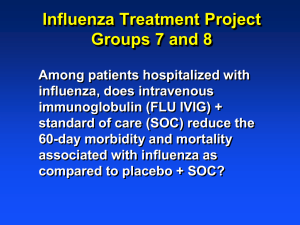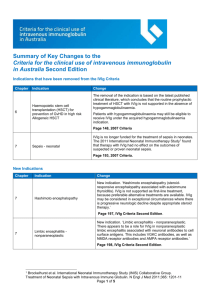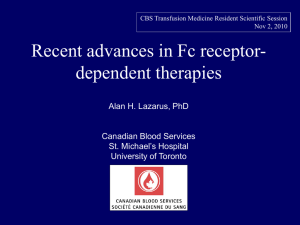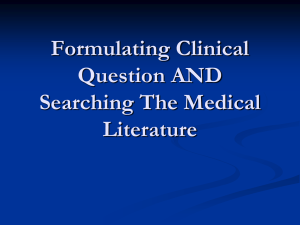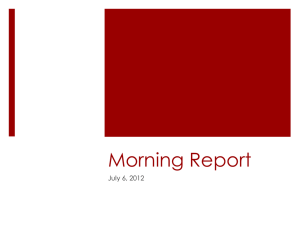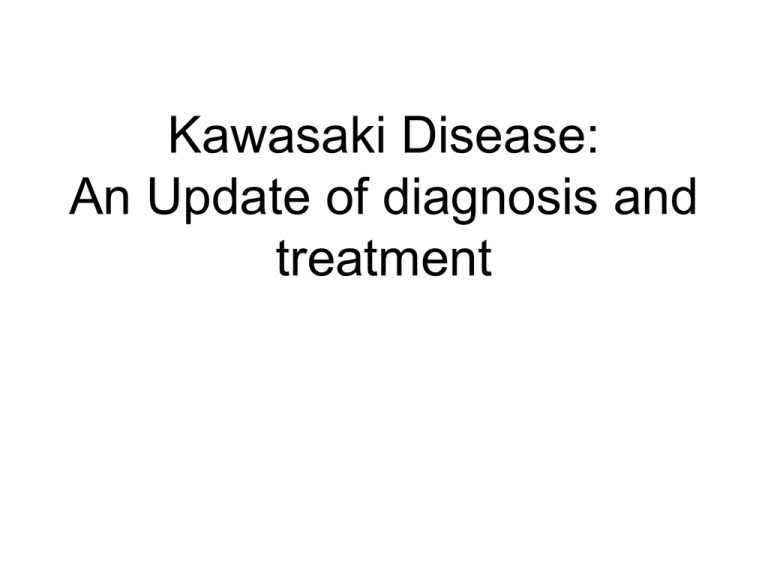
Kawasaki Disease:
An Update of diagnosis and
treatment
What is Kawasaki Disease?
• Idiopathic multisystem disease
characterized by vasculitis of small &
medium blood vessels, including
coronary arteries
Diagnostic Criteria
•
•
Fever for at least 5 days
At least 4 of the following 5 features:
1. Changes in the extremities
Edema, erythema, desquamation
2. Polymorphous exanthem, usually truncal
3. Conjunctival injection
4. Erythema&/or fissuring of lips and oral cavity
5. Cervical lymphadenopathy
•
Illness not explained by other known
disease process
Modified from Centers for Disease Control. Kawasaki Disease. MMWR 29:61-63,
1980
Atypical or Incomplete
Kawasaki Disease
•
•
•
•
•
Present with < 4 of 5 diagnostic criteria
Compatible laboratory findings
Still develop coronary artery aneurysms
No other explanation for the illness
More common in children < 1 year of
age
• 2004 AHA guidelines offer new
evaluation and treatment algorithm
Phases of Disease
• Acute (1-2 weeks from onset)
– Febrile, irritable, toxic appearing
– Oral changes, rash, edema/erythema of feet
• Subacute (2-8 weeks from onset)
– Desquamation, may have persistent arthritis
or arthralgias
– Gradual improvement even without treatment
• Convalescent (Months to years later)
• AHA classify coronary
arteries aneurysms
– Small (5 mm internal
diameter),
– medium (5 to 8 mm
internal
– diameter),
– or giant (8 mm internal
diameter).
• The Japanese Ministry of
Health Classify coronary
arteries as
abnormal
• the internal lumen
diameter is 3 mm in
children 5 years old or 4
mm in children 5 years
old;
• the internal diameter of
a segment measures 1.5
times that of an adjacent
segment;
Abnormal coronary
artery
Diameter of CA /BSA
Coronary Artery Involvement in
Children With Kawasaki Disease:
Risk Factors
Harada et al – risk score
(1) white blood cell count 12 000/mm3;
(2) platelet count 350 000/mm3;
(3) CRP 3;
(4) hematocrit 35%
(5) albumin 3.5 g/dL;
(6) age 12 months;
(7) male sex.
4/7 : high risk
ASAI
Symtomps
1.
2.
3.
4.
5.
6.
7.
8.
9.
10.
11.
12.
13.
14.
0 điểm
Sex
Nữ
Age
1
Days of fever
< 14
Recurrent fever
Recurrent rash
Recurrent bong da
Anemie (Hb < 10g/dL)
WBC(X 103/ mm3)
< 26
VS(mm)
< 60
VS and PLT high for a long
<1
time(months )
Enlarge CI
Abnormal rymth
Ischemic myocady
pericarditis
9/23 điểm : high risk
1 điểm
Nam
>1
14 -15
+
26 – 30
60 – 100
2 điểm
16
+
+
+
> 30
> 100
>1
+
+
+
+
+
ĐIỀU TRỊ ASPIRIN
• AHA-2004: 80-100 mg/kg.
• Pediatrics-1995: meta-analysis.
Control
ASA
ASA+IVIG 1g/kg
ASA+IVIG >1g/kg
Ratio Dilated CA
after 30 days (n=2547)
After 60 days (n=4151)
22.8% ( 95% CI: 20.625%)
17.3%(95% CI: 14.320.2%)
10.3%( 95% CI: 8.312.3%)
2.3%(95% CI: 0.5-4.2%)
17.1%(95% CI: 13.6-20.7%)
ASA+ IVIG >1g/kg lieàu duy
nhaát
IVIG >1g/kg + ASA <80
13%(95% CI: 9-17%)
mg/kg
IVIG
>1g/kg
+ASA 9.1% (95% CI: 6.9-11.4%)
>80mg/kg
11.1%(95% CI: 8.7-13.6%)
4.4% (95% CI: 2.8-6%)
2.4%(95% CI: 0.5-4.2%)
4.8%(95% CI: 2.3-7.4%)
4%(95% CI: 2.-6.1%)
Dilated CA in 30 days
Dilated CA in 60 days
IVIG (2G/KG/D) < IVIG 1G/KG < ASA
IVIG (2G/KG/D) < IVIG 1G/KG < ASA
IVIG HIGH DOSE + ASA HIGH DOSE =
IVIG HIGH DOSE + ASA LOW DOSE
IVIG HIGH DOSE + ASA HIGH DOSE
= IVIG HIGH DOSE + ASA LOW
DOSE
ASPIRIN vs IVIG
TỈ LỆ TỔN THƯƠNG MẠCH VÀNH
IVIG+ASPIRIN
-IVIG HIGH DOSE
-IVIG LOW DOSE
ASPIRIN
CORTICOID
1. Initial CORTICOID vs ASPIRIN.
2. Initial CORTICOID+ ASPIRIN+ IVIG vs
ASPIRIN+IVIG.
3. Resistance IVIG.
IVIG+ASPIRIN vs IVIG+ASPIRIN+ METHYPREDNISOLON
Randomized Trial of Pulsed Corticosteroid Therapy for Primary Treatment of Kawasaki
Disease. N Engl J Med 2007;356:663-75.
- 30 mg/kg over 2 to 3 hours
- IVIG 2g/kg.
- Aspirin 80-100mg/kg.
Effect and result
• Response with IVIG : 90 %
• No response with IVIG : 10 %
Prediction of Intravenous Immunoglobulin Unresponsiveness in Patients With
Kawasaki disease. Circulation 2006;113;2606-2612; published online May 30, 2006;
http://circ.ahajournals.org/cgi/content/full/113/22/2606.
Kobayashi-2006
Prediction of Intravenous Immunoglobulin Unresponsiveness in Patients With
Kawasaki disease. Circulation 2006;113;2606-2612; published online May 30, 2006;
http://circ.ahajournals.org/cgi/content/full/113/22/2606.
TIÊN ĐÓAN TỔN THƯƠNG MẠCH VÀNH
ANTI IVIG
• IVIG ONLY 2 g/kg (evidence level C).
• STEROID ONLY.
• PULSE STEROID + IVIG: Hashino et al + RCT.
– 17 patients who did not respond to an initial infusion of 2 g/kg IVIG plus
aspirin followed by an additional IVIG infusion of 1 g/kg.
– Randomized to receive either a single additional dose of IVIG (1 g/kg)
or pulse steroid therapy.
– RESULT:
• Patients in the steroidgroup had a shorter duration of fever and lower
medical costs.
• No significant difference in the incidence of coronary arteryaneurysms was
noted between the 2 groups, but power to detect a difference was limited.
KHÁNG IVIG
AHA-2004 recommends
1.Steroid treatment berestricted to children
in whom 2 infusions of IVIG have been
ineffective in alleviating fever and acute
inflammation (evidence level C).
2.The most commonly used steroid regimen
is intravenous pulse methylprednisolone,
30 mg/kg for 2 to 3 hours, administered
once daily for 1 to 3 days.
Acute Kawasaki Disease: Conclusion
for Treatment ( AHA 2004)
• IVIG: 2g/kg as one-time dose
– Beneficial effect 1st reported by
Japanese
– Mechanism of action is unclear
– Significant reduction in CAA in pts
treated with IVIG plus aspirin vs. aspirin
alone (15-25%3-5%)
Acute Kawasaki Disease:
Treatment
• IVIG
– 70-90% defervesce & show symptom
resolution within 2-3 days of treatment
– Retreat those with failure of response to
1st dose or recurrent symptoms Up to
2/3 respond to a second course
Acute Kawasaki Disease:
Treatment
• Aspirin
– High dose (80-100 mg/kg/day) until
afebrile x 48 hrs &/or decrease in acute
phase reactants
– Need high doses in acute phase due to
malabsorption of ASA
– Dosage of ASA in acute phase does not
seem to affect subsequent incidence of
CAA
Acute Kawasaki Disease:
Treatment
• Aspirin
– Decrease to low dose (3-5 mg/kg/day) for
6-8 weeks or until platelet levels
normalize ( evidence level C).
– No evidence /effect on CAA when used
alone
– Due to potential risk of Reye syndrome
instruct parents about symptoms of
influenza or varicella
In case of persistent or recrudescent fever:
Repeat dose of IVIG 2 g/kg as single
infusion; consider IV methylprednisolone
30 mg/kg once a day; may be repeated as
necessary up to a total of three doses

